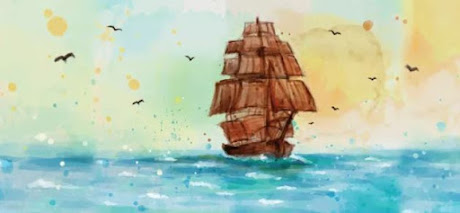The ship will still float, even if one part is shattered:
Nicole Dei Conti in 1420 CE wrote about his admiration for Indian skill in shipbuilding: “The native of India build some ships larger than ours, capable of containing 2,000 butts. Some ships are so built-in compartments that should one part be shattered, the other portion remaining, the same may accomplish the voyage.”
They came to learn shipbuilding:
Indian shipbuilding technologies were studied and acquired by the famed Chinese Admiral Zheng He, who sent his famous chronicler and interpreter Ma Huan, to Bengal’s shipbuilding yards, during the Ming dynasty in the early 15th century (1400-1410 CE).
India had a 25 percent share in world trade before the British Rule. One of the secrets to India’s prosperity and resilience over the last few millennia was attributed to navigational and architectural skills to build the long distance, seaworthy ships and ports and harbors for trade around the globe.
With an 8,500 km-long coastline, and warm water throughout the year, India had maritime activity for thousands of years. From medieval times 5,000 years ago, India had well-developed ports and an extensive navigational system.
India had dominated the waters of the world and global trade scenario for millennia with her well-crafted ships, the huge volume of trade and with “naav (boat) the word for sea travel.
From Baluch and Sind in the West to East Bengal, India’s naval activity spanned at the very minimum from the east coast of Africa to South East Asian islands and beyond, even to the west coast of the Americas.
The father and son duo of Raja
Raja Chola and Rajendra Chola of South India undertook many sea conquests
towards the South East Asian islands. Between them and their immediate
predecessors and successors, the Cholas dominated the maritime activity of the
eastern seas for 200 years (between 850 CE and 1088 CE).
Trade with Egypt, Damascus, Tyre, Mesopotamia, Arabia, and Dilmun (modern Bahrain-Oman) flourished. In comparison, European naval activity, till about 1400s, was limited to the Mediterranean Sea and the east coast of the Atlantic Ocean.
Indian ships led Vasco da Gama
Vasco da Gama, the Portuguese explorer, sailed in the largest ships of his times, the 28-meter-long Sao Gabriel.
Vasco da Gama reached India sailing around Africa in 1497 and is credited with having found the sea route to India. He travelled down the Atlantic Ocean from Cape Verde to the Cape of Good Hope in South Africa.
He wrote in his logbook diary, which is now in the Lisbon Maritime Museum that when he came to South Africa, he saw Indian ships ten times the size of his own ship.
Ship name | Country | Length |
| Santa Maria (belonged to Christopher Columbus) | America | Over 20 meters |
| Sao Gabriel (Vasco da Gama) | Portugal | Over 30 meters |
| Gamini | India | 50 meters |
| Tari | India | 60 meters |
| Janghala | India | Over 60 meters |
| Plavini | India | Over 70 meters |
| Dharini | India | 80 meters |
| Begini | India | Almost 90 meters |
Then, when faced with the daunting challenge of having to travel in the Indian Ocean waters towards India, he saw large Indian ships travelling back to India from the east coast of Africa. It was in the midst of these Indian ships that Vasco da Gama travelled mid seas to India.
These ships guided him to the Malabar coast of India and landed in Kozhikode, later called Calicut by the colonial writers. There, he paid his respects to the local king referred to as Samuthirai, meaning one who is the king of the seas. Samudra is seas and Rai or Raja is king.
భారతదేశానికి సముద్రమార్గాన్ని కనుగొన్నవాడు వాస్కోడగామా అనడం ఎంతవరకు సత్యం?




